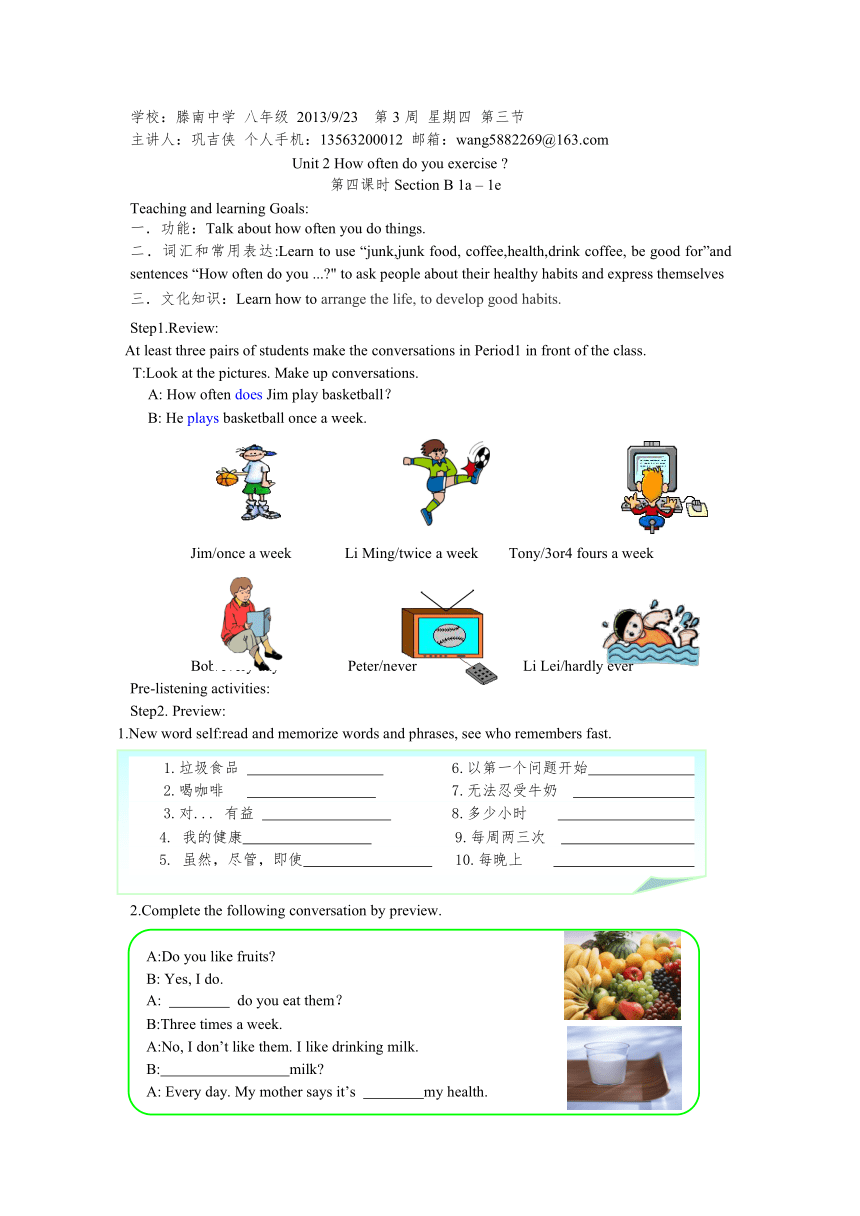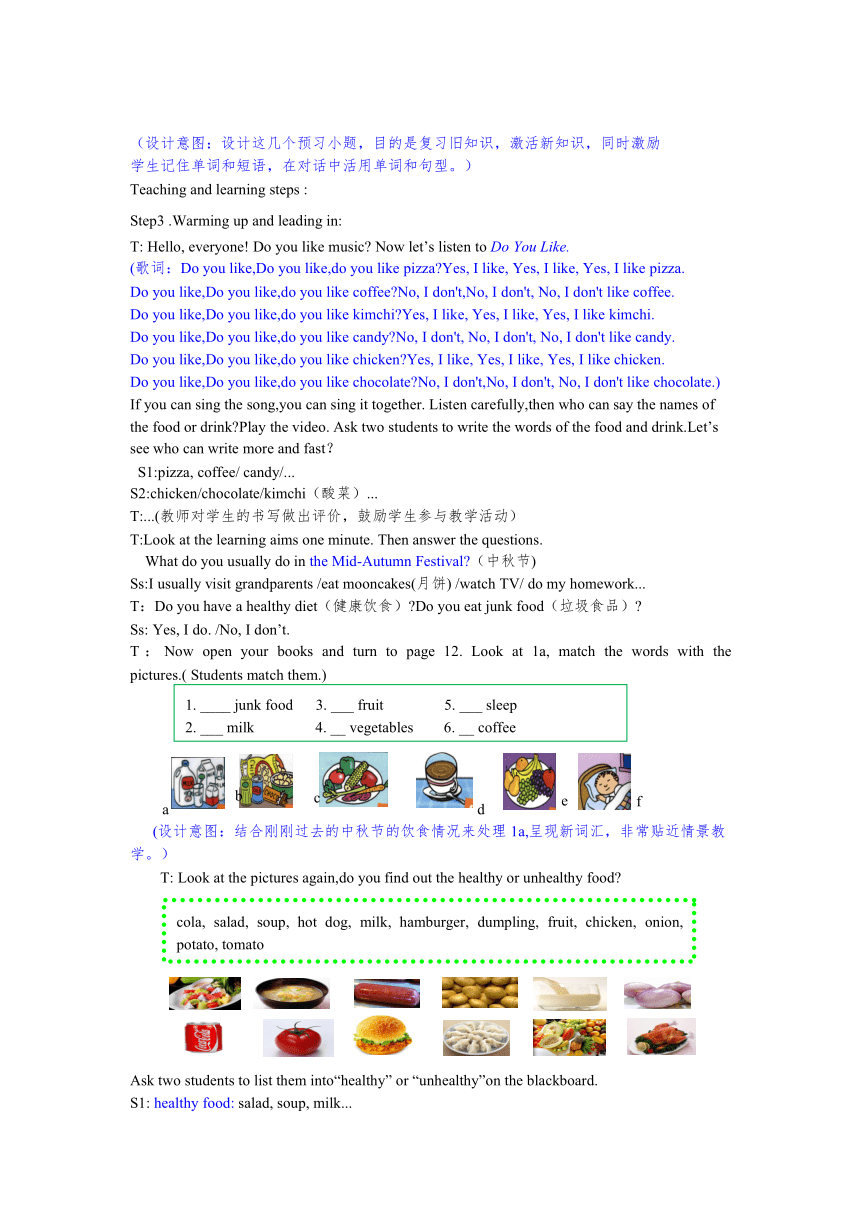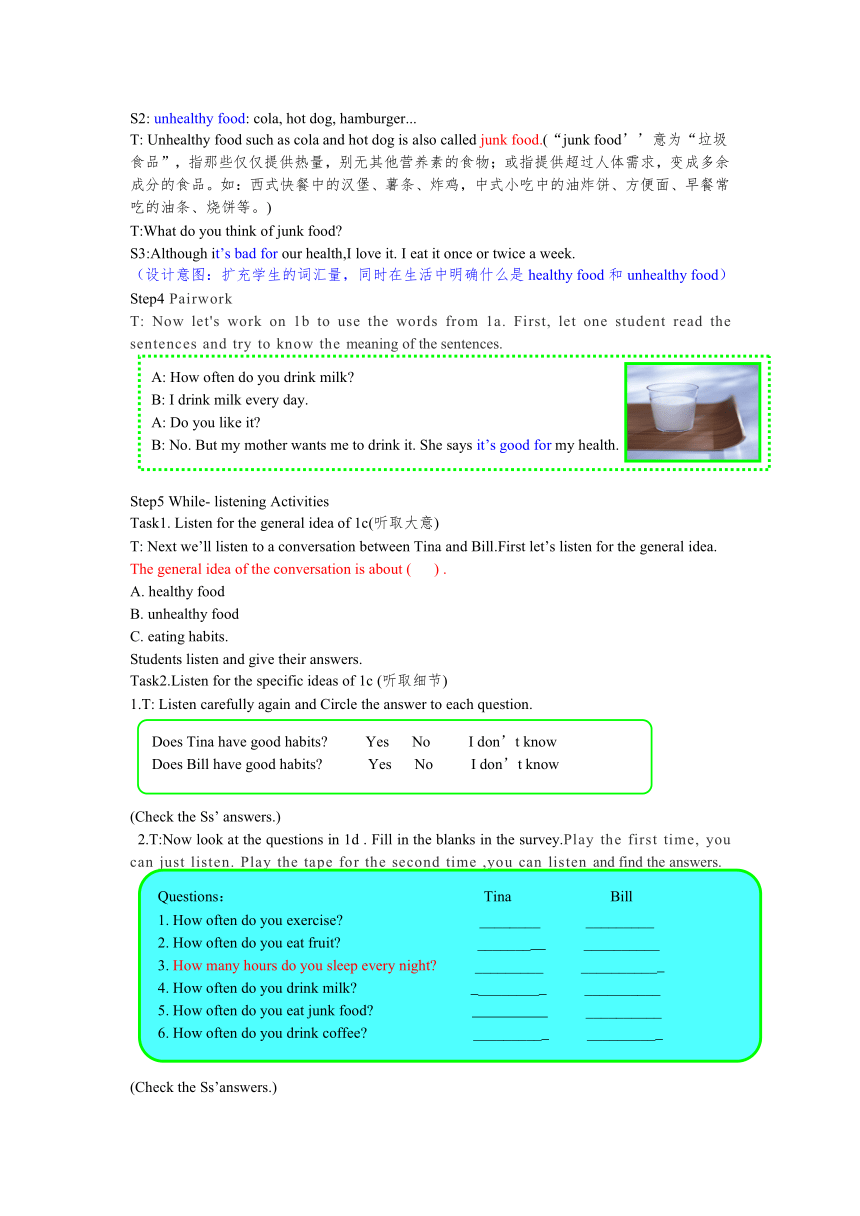Unit 2 How often do you exercise ?第四课时教案Section B (1a – 1e)
文档属性
| 名称 | Unit 2 How often do you exercise ?第四课时教案Section B (1a – 1e) |  | |
| 格式 | zip | ||
| 文件大小 | 3.3MB | ||
| 资源类型 | 教案 | ||
| 版本资源 | 人教新目标(Go for it)版 | ||
| 科目 | 英语 | ||
| 更新时间 | 2014-06-23 11:44:22 | ||
图片预览



文档简介
学校:滕南中学 八年级 2013/9/23 第3周 星期四 第三节
主讲人:巩吉侠 个人手机:13563200012 邮箱:wang5882269@163.com
Unit 2 How often do you exercise ?
第四课时Section B 1a – 1e
Teaching and learning Goals:
一.功能:Talk about how often you do things.
二.词汇和常用表达:Learn to use “junk,junk food, coffee,health,drink coffee, be good for”and sentences “How often do you ...?" to ask people about their healthy habits and express themselves
三.文化知识:Learn how to arrange the life, to develop good habits.
Step1.Review:
At least three pairs of students make the conversations in Period1 in front of the class.
T:Look at the pictures. Make up conversations.
A: How often does Jim play basketball?
B: He plays basketball once a week.
Jim/once a week Li Ming/twice a week Tony/3or4 fours a week
Bob/every day Peter/never Li Lei/hardly ever
Pre-listening activities:
Step2. Preview:
1.New word self:read and memorize words and phrases, see who remembers fast.
2.Complete the following conversation by preview.
(设计意图:设计这几个预习小题,目的是复习旧知识,激活新知识,同时激励
学生记住单词和短语,在对话中活用单词和句型。)
Teaching and learning steps :
Step3 .Warming up and leading in:
T: Hello, everyone! Do you like music? Now let’s listen to Do You Like.
(歌词:Do you like,Do you like,do you like pizza?Yes, I like, Yes, I like, Yes, I like pizza. Do you like,Do you like,do you like coffee?No, I don't,No, I don't, No, I don't like coffee. Do you like,Do you like,do you like kimchi?Yes, I like, Yes, I like, Yes, I like kimchi. Do you like,Do you like,do you like candy?No, I don't, No, I don't, No, I don't like candy. Do you like,Do you like,do you like chicken?Yes, I like, Yes, I like, Yes, I like chicken. Do you like,Do you like,do you like chocolate?No, I don't,No, I don't, No, I don't like chocolate.)
If you can sing the song,you can sing it together. Listen carefully,then who can say the names of the food or drink?Play the video. Ask two students to write the words of the food and drink.Let’s see who can write more and fast?
S1:pizza, coffee/ candy/...
S2:chicken/chocolate/kimchi(酸菜)...
T:...(教师对学生的书写做出评价,鼓励学生参与教学活动)
T:Look at the learning aims one minute. Then answer the questions.
What do you usually do in the Mid-Autumn Festival?(中秋节)
Ss:I usually visit grandparents /eat mooncakes(月饼) /watch TV/ do my homework...
T:Do you have a healthy diet(健康饮食)?Do you eat junk food(垃圾食品)?
Ss: Yes, I do. /No, I don’t.
T:Now open your books and turn to page 12. Look at 1a, match the words with the pictures.( Students match them.)
(设计意图:结合刚刚过去的中秋节的饮食情况来处理1a,呈现新词汇,非常贴近情景教学。)
T: Look at the pictures again,do you find out the healthy or unhealthy food?
Ask two students to list them into“healthy” or “unhealthy”on the blackboard.
S1: healthy food: salad, soup, milk...
S2: unhealthy food: cola, hot dog, hamburger...
T: Unhealthy food such as cola and hot dog is also called junk food.(“junk food’’意为“垃圾食品”,指那些仅仅提供热量,别无其他营养素的食物;或指提供超过人体需求,变成多余成分的食品。如:西式快餐中的汉堡、薯条、炸鸡,中式小吃中的油炸饼、方便面、早餐常吃的油条、烧饼等。)
T:What do you think of junk food?
S3:Although it’s bad for our health,I love it. I eat it once or twice a week.
(设计意图:扩充学生的词汇量,同时在生活中明确什么是healthy food和unhealthy food)
Step4 Pairwork
T: Now let's work on 1b to use the words from 1a. First, let one student read the sentences and try to know the meaning of the sentences.
Step5 While- listening Activities
Task1. Listen for the general idea of 1c(听取大意)
T: Next we’ll listen to a conversation between Tina and Bill.First let’s listen for the general idea.
The general idea of the conversation is about ( ) .
A. healthy food
B. unhealthy food
C. eating habits.
Students listen and give their answers.
Task2.Listen for the specific ideas of 1c (听取细节)
1.T: Listen carefully again and Circle the answer to each question.
(Check the Ss’ answers.)
2.T:Now look at the questions in 1d . Fill in the blanks in the survey.Play the first time, you can just listen. Play the tape for the second time ,you can listen and find the answers.
(Check the Ss’answers.)
(设计意图:通过层层递进的听力任务设计,尽量给学生以足够的听的机会。听力指导:学生先要抓住这六个问题的意思。带着这六个问题去对话。在听的时候,应重点将与这六个问题相关的回答听清,其他作为非重点内容。)
3. Listen and repeat.
T: I’ll play the recording again. You’ll repeat it after the tape.
(设计意图:通过跟读模仿语言,纠正单词发音,关注对话中的语音语调和感彩。)
Step6 .Post-listening Activities
Task1. Pairwork.
Role play. Student A is the reporter. Student B is Tina or Bill. Try to act the conversation out .They can use their own words.
(设计意图:就1d进一步进行练习,巩固目标语言。在与学生愉快地谈论各种活动的过程中很自然地呈现出频率副词的用法,然后运用学过的句型进行操练。)
Task2.1. Get Ss to make a survey about what Tina ’s and Bill’s eating habits are,then report it in the front of the class.Make a survey using information in1d,like this:
Report it like this:
(设计意图:就Tina 和Bill的饮食情况做个汇报,训练学生综合运用语言的能力。本环节亦可实施分层教学,英语成绩较好的同学当堂完成汇报任务,基础一般的同学可根据参与程度进行评价,课下试着写出。)
Step7.Inquiry knowledge by translation(翻译探究)
In this class we have learned to talk about how often they do things to keep healthy.
Discuss in groups of four, then fill in the blanks.
(设计意图:“翻译探究”的主要目的是变老师讲解语言知识为学生自学语言知识。教师要引导学生们运用观察、发现、归纳和实践等方法,通过小组合作探究的形式来获得更为准确的答案。)
Step8. Teacher’s words
T: And you know: Healthy lifestyle can help us get good grades. Good food and exercise help us to study better. Look at saying.
(设计意图: 结合名言警句,让学生们知道应如何安排自己的日常生活,向其他有良好生活习惯的人们学习,做一个有良好习惯的人。)
Step9. The end-of class test 当堂检测
一.用所给词的适当形式填空
1. My father plays basketball_____(two) a week.
2. My mother wants me _____(drink) some milk every day.
3. Jodie often ____(exercise) in the park.
4. You must try _____(eat)less meat.
5. Good sleep can help you to study _____(well).
二.请翻译下列句子。
1.她很少一个人出去。
She ______ ______ goes out alone.
2. 你的妈妈多长时间回家一次?
_____ _____ does your mother go home?
一月三、四次。
______ _____ _____ ______ a month.
3. 多吃蔬菜对你的健康有好处。
Eating more vegetables _____ _____ _____ ____ 。
(设计意图:通过当堂检测,检测学生本节课知识点掌握情况,仔细分析易错点和易混点,为下一堂课教学确定知识目标。)
Step10. Homework.
1.Read 1c after the recording and recite them.(★)
2.Talk about your eating habits,then write a report
and read to your classmates in class.(★★)
4.Preview 2a---2b. (★★))
(设计意图:分层布置作业。对于听力原文,可让生反复听磁带,复述大意,进一步形成良好的语感。对学有余力的同学,可进行综合写作技能的强化训练,并准备下节课课前汇报。)
教学反思:
在本节课一开始,我依据一首外语歌曲Do You Like,引起学生们的兴趣,听得同时布置任务,写出食物和饮料的名称,自然而然的导入新课。听力训练凸显层次性。先对听力材料的梗概大意进行听力回答,接着分段完成1c,1d问题。能根据所学语言来进行对话。学生能根据教师提供的情景,在教师指导下,学生能尝试回忆关键词、句型,进行语言的组织,已达到对话的目的。
本课亮点:
在情境中训练语言的生成性。根据所学的词汇、短语进行编写对话,学以致用所学的知识点和语法。用所获得信息自己组织语言进行班级汇报,有效地锻炼了学生的语言组织能力和表达能力。
不足:
听力内容教长,未做挖空练习,而改成让生汇报Tina 和Bill的饮食习惯。
使用建议:
1、听力训练中的任务设计较为详细、全面,教师可根据实际合理地使用。如:“补全对话”和正音两个环节,为避免听的重复性,教师可选择合并在一起。
2、在翻译探究活动中要注意让学生讨论观察,然后形成自己的见解后再对照答案,不能让“合作探究”变成无效的活动。
参考答案:
Step2. Pre-listening activities.
Preview
1. Words and Phrases:?
junk food 6.start with
drink coffee 7.can’t stand milk
be good for 8.how many hours
4. my health 9.twice or three times a week
although 10.every night
2 . Complete the following conversation by preview.
How often, How often do you drink ,good for
?Step5. While-listening
Listen for the general idea听取大意(C)
2.Listen for the specific ideas听取细节
Task1.①yes.②no.
Task2. 1.every day/ hardly ever 2.every day/ never 3.nine/nine 4.every day/ never 4.two or three times a week/ 5.three or four times a week 6. never/ four times a day
Step6 .Post-listening Activities ,exercises,sleeps
Tina: drinks milk,eats junk food, drink coffee,nine hours.
Bill: sleeps, exercises, fruit,eats junk food, drinks coffee
Step7. Inquiry into knowledge by translation.
对...有好处,对...有害处,is good for,名,形容词,Health, healthy
Step9.The end-of- class test当堂检测
一、 1.twice 2. to drink 3. exercises 4.to eat 5. well
二、 1. hardly ever 2.How often , Three or four times 3. is good for
主讲人:巩吉侠 个人手机:13563200012 邮箱:wang5882269@163.com
Unit 2 How often do you exercise ?
第四课时Section B 1a – 1e
Teaching and learning Goals:
一.功能:Talk about how often you do things.
二.词汇和常用表达:Learn to use “junk,junk food, coffee,health,drink coffee, be good for”and sentences “How often do you ...?" to ask people about their healthy habits and express themselves
三.文化知识:Learn how to arrange the life, to develop good habits.
Step1.Review:
At least three pairs of students make the conversations in Period1 in front of the class.
T:Look at the pictures. Make up conversations.
A: How often does Jim play basketball?
B: He plays basketball once a week.
Jim/once a week Li Ming/twice a week Tony/3or4 fours a week
Bob/every day Peter/never Li Lei/hardly ever
Pre-listening activities:
Step2. Preview:
1.New word self:read and memorize words and phrases, see who remembers fast.
2.Complete the following conversation by preview.
(设计意图:设计这几个预习小题,目的是复习旧知识,激活新知识,同时激励
学生记住单词和短语,在对话中活用单词和句型。)
Teaching and learning steps :
Step3 .Warming up and leading in:
T: Hello, everyone! Do you like music? Now let’s listen to Do You Like.
(歌词:Do you like,Do you like,do you like pizza?Yes, I like, Yes, I like, Yes, I like pizza. Do you like,Do you like,do you like coffee?No, I don't,No, I don't, No, I don't like coffee. Do you like,Do you like,do you like kimchi?Yes, I like, Yes, I like, Yes, I like kimchi. Do you like,Do you like,do you like candy?No, I don't, No, I don't, No, I don't like candy. Do you like,Do you like,do you like chicken?Yes, I like, Yes, I like, Yes, I like chicken. Do you like,Do you like,do you like chocolate?No, I don't,No, I don't, No, I don't like chocolate.)
If you can sing the song,you can sing it together. Listen carefully,then who can say the names of the food or drink?Play the video. Ask two students to write the words of the food and drink.Let’s see who can write more and fast?
S1:pizza, coffee/ candy/...
S2:chicken/chocolate/kimchi(酸菜)...
T:...(教师对学生的书写做出评价,鼓励学生参与教学活动)
T:Look at the learning aims one minute. Then answer the questions.
What do you usually do in the Mid-Autumn Festival?(中秋节)
Ss:I usually visit grandparents /eat mooncakes(月饼) /watch TV/ do my homework...
T:Do you have a healthy diet(健康饮食)?Do you eat junk food(垃圾食品)?
Ss: Yes, I do. /No, I don’t.
T:Now open your books and turn to page 12. Look at 1a, match the words with the pictures.( Students match them.)
(设计意图:结合刚刚过去的中秋节的饮食情况来处理1a,呈现新词汇,非常贴近情景教学。)
T: Look at the pictures again,do you find out the healthy or unhealthy food?
Ask two students to list them into“healthy” or “unhealthy”on the blackboard.
S1: healthy food: salad, soup, milk...
S2: unhealthy food: cola, hot dog, hamburger...
T: Unhealthy food such as cola and hot dog is also called junk food.(“junk food’’意为“垃圾食品”,指那些仅仅提供热量,别无其他营养素的食物;或指提供超过人体需求,变成多余成分的食品。如:西式快餐中的汉堡、薯条、炸鸡,中式小吃中的油炸饼、方便面、早餐常吃的油条、烧饼等。)
T:What do you think of junk food?
S3:Although it’s bad for our health,I love it. I eat it once or twice a week.
(设计意图:扩充学生的词汇量,同时在生活中明确什么是healthy food和unhealthy food)
Step4 Pairwork
T: Now let's work on 1b to use the words from 1a. First, let one student read the sentences and try to know the meaning of the sentences.
Step5 While- listening Activities
Task1. Listen for the general idea of 1c(听取大意)
T: Next we’ll listen to a conversation between Tina and Bill.First let’s listen for the general idea.
The general idea of the conversation is about ( ) .
A. healthy food
B. unhealthy food
C. eating habits.
Students listen and give their answers.
Task2.Listen for the specific ideas of 1c (听取细节)
1.T: Listen carefully again and Circle the answer to each question.
(Check the Ss’ answers.)
2.T:Now look at the questions in 1d . Fill in the blanks in the survey.Play the first time, you can just listen. Play the tape for the second time ,you can listen and find the answers.
(Check the Ss’answers.)
(设计意图:通过层层递进的听力任务设计,尽量给学生以足够的听的机会。听力指导:学生先要抓住这六个问题的意思。带着这六个问题去对话。在听的时候,应重点将与这六个问题相关的回答听清,其他作为非重点内容。)
3. Listen and repeat.
T: I’ll play the recording again. You’ll repeat it after the tape.
(设计意图:通过跟读模仿语言,纠正单词发音,关注对话中的语音语调和感彩。)
Step6 .Post-listening Activities
Task1. Pairwork.
Role play. Student A is the reporter. Student B is Tina or Bill. Try to act the conversation out .They can use their own words.
(设计意图:就1d进一步进行练习,巩固目标语言。在与学生愉快地谈论各种活动的过程中很自然地呈现出频率副词的用法,然后运用学过的句型进行操练。)
Task2.1. Get Ss to make a survey about what Tina ’s and Bill’s eating habits are,then report it in the front of the class.Make a survey using information in1d,like this:
Report it like this:
(设计意图:就Tina 和Bill的饮食情况做个汇报,训练学生综合运用语言的能力。本环节亦可实施分层教学,英语成绩较好的同学当堂完成汇报任务,基础一般的同学可根据参与程度进行评价,课下试着写出。)
Step7.Inquiry knowledge by translation(翻译探究)
In this class we have learned to talk about how often they do things to keep healthy.
Discuss in groups of four, then fill in the blanks.
(设计意图:“翻译探究”的主要目的是变老师讲解语言知识为学生自学语言知识。教师要引导学生们运用观察、发现、归纳和实践等方法,通过小组合作探究的形式来获得更为准确的答案。)
Step8. Teacher’s words
T: And you know: Healthy lifestyle can help us get good grades. Good food and exercise help us to study better. Look at saying.
(设计意图: 结合名言警句,让学生们知道应如何安排自己的日常生活,向其他有良好生活习惯的人们学习,做一个有良好习惯的人。)
Step9. The end-of class test 当堂检测
一.用所给词的适当形式填空
1. My father plays basketball_____(two) a week.
2. My mother wants me _____(drink) some milk every day.
3. Jodie often ____(exercise) in the park.
4. You must try _____(eat)less meat.
5. Good sleep can help you to study _____(well).
二.请翻译下列句子。
1.她很少一个人出去。
She ______ ______ goes out alone.
2. 你的妈妈多长时间回家一次?
_____ _____ does your mother go home?
一月三、四次。
______ _____ _____ ______ a month.
3. 多吃蔬菜对你的健康有好处。
Eating more vegetables _____ _____ _____ ____ 。
(设计意图:通过当堂检测,检测学生本节课知识点掌握情况,仔细分析易错点和易混点,为下一堂课教学确定知识目标。)
Step10. Homework.
1.Read 1c after the recording and recite them.(★)
2.Talk about your eating habits,then write a report
and read to your classmates in class.(★★)
4.Preview 2a---2b. (★★))
(设计意图:分层布置作业。对于听力原文,可让生反复听磁带,复述大意,进一步形成良好的语感。对学有余力的同学,可进行综合写作技能的强化训练,并准备下节课课前汇报。)
教学反思:
在本节课一开始,我依据一首外语歌曲Do You Like,引起学生们的兴趣,听得同时布置任务,写出食物和饮料的名称,自然而然的导入新课。听力训练凸显层次性。先对听力材料的梗概大意进行听力回答,接着分段完成1c,1d问题。能根据所学语言来进行对话。学生能根据教师提供的情景,在教师指导下,学生能尝试回忆关键词、句型,进行语言的组织,已达到对话的目的。
本课亮点:
在情境中训练语言的生成性。根据所学的词汇、短语进行编写对话,学以致用所学的知识点和语法。用所获得信息自己组织语言进行班级汇报,有效地锻炼了学生的语言组织能力和表达能力。
不足:
听力内容教长,未做挖空练习,而改成让生汇报Tina 和Bill的饮食习惯。
使用建议:
1、听力训练中的任务设计较为详细、全面,教师可根据实际合理地使用。如:“补全对话”和正音两个环节,为避免听的重复性,教师可选择合并在一起。
2、在翻译探究活动中要注意让学生讨论观察,然后形成自己的见解后再对照答案,不能让“合作探究”变成无效的活动。
参考答案:
Step2. Pre-listening activities.
Preview
1. Words and Phrases:?
junk food 6.start with
drink coffee 7.can’t stand milk
be good for 8.how many hours
4. my health 9.twice or three times a week
although 10.every night
2 . Complete the following conversation by preview.
How often, How often do you drink ,good for
?Step5. While-listening
Listen for the general idea听取大意(C)
2.Listen for the specific ideas听取细节
Task1.①yes.②no.
Task2. 1.every day/ hardly ever 2.every day/ never 3.nine/nine 4.every day/ never 4.two or three times a week/ 5.three or four times a week 6. never/ four times a day
Step6 .Post-listening Activities ,exercises,sleeps
Tina: drinks milk,eats junk food, drink coffee,nine hours.
Bill: sleeps, exercises, fruit,eats junk food, drinks coffee
Step7. Inquiry into knowledge by translation.
对...有好处,对...有害处,is good for,名,形容词,Health, healthy
Step9.The end-of- class test当堂检测
一、 1.twice 2. to drink 3. exercises 4.to eat 5. well
二、 1. hardly ever 2.How often , Three or four times 3. is good for
同课章节目录
- Unit 1 Where did you go on vacation?
- Section A
- Section B
- Unit 2 How often do you exercise?
- Section A
- Section B
- Unit 3 I'm more outgoing than my sister.
- Section A
- Section B
- Unit 4 What's the best movie theater?
- Section A
- Section B
- Unit 5 Do you want to watch a game show?
- Section A
- Section B
- Unit 6 I'm going to study computer science.
- Section A
- Section B
- Unit 7 Will people have robots?
- Section A
- Section B
- Unit 8 How do you make a banana milk shake?
- Section A
- Section B
- Unit 9 Can you come to my party?
- Section A
- Section B
- Unit 10 If you go to the party, you'll have a grea
- Section A
- Section B
